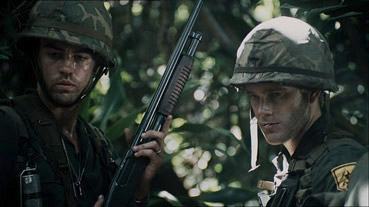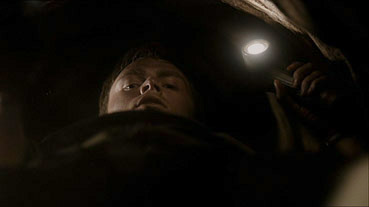|
If you know your low budget horror then you should be familiar with the name Uwe Boll. You'll probably even have an opinion on the man and his work, and there's a good chance it's not a complimentary one. If the name is new to you then you'll find some background to his infamy in my review of his 2007 film Seed. If you want to cut to the chase then all you need to know for now is that he specialises in horror and video game adaptations, has more films in the IMDb bottom 100 than any other living or dead filmmaker, and is regarded by several commentators as the worst director alive. Personally I think that's a bit harsh, but the prospect of a Uwe Boll all-nighter is not one I'd personally relish. So before I go any further I should establish two things about his most recent film, Tunnel Rats (also known as 1968 Tunnel Rats). First, it's neither a horror movie nor a video game adaptation (although in a new twist, Boll is apparently producing a game of the film). Second, it's actually rather good. No, really.
Tunnel Rats is set in 1968 during the Vietnam war and tells the story of an American army platoon who have copped the unenviable task of infiltrating the complex network of underground tunnels used by the Viet Cong to hide and move around undetected by their enemy. It's a dangerous job that involves crawling along narrow, unlit passageways that are peppered with booby traps and armed Viet Cong soldiers, something that the outfit's new recruits soon discover to their considerable cost.

Now when I say this is not a horror film I do have to add a qualifying 'but' to that. Tunnel Rats is on the surface a Vietnam war movie, but (here it comes) with a recognisable horror movie structure. A group of youngsters meet up, hang loose in each other's company, and then enter a situation in which they are violently picked off one by one. Will any survive? Only time will tell...
Relocating a horror structure in a war movie setting may seem like dressing up an old dog in military clothing, but it does make a surprising difference. For a start, the potential victims are drawn from the Vietnam movie stock rather than the teen horror catalogue and are a more instantly likeable and believable bunch. The first half-hour is spent just hanging out with the soldiers in camp, and despite some clunky "thinking of home" moments, this works pretty well. The performances have a pleasingly naturalistic restraint, and beneath the seemingly innocuous chat you can feel a very real sense of building foreboding for the task ahead.
Less successful is the attempt to establish the soldiers as distinctive individuals with whom we can bond and later fret for when they are placed in danger. I thought I had a handle on some, but half-an-hour after the tunnel mission kicks off I'd actually lost track of who was who, which of the poor unfortunates were still alive, and in one case exactly where they were. This is partly eased by a reliance on war movie rookie staples and borrowed characters – there's a dead ringer for the wide-eyed Mark Hamill in The Big Red One, and Boll regular Michael Paré's don't-fuck-with-me Lieutenant Hollowborn has been lifted wholesale from Tom Berenger's Sergeant Barnes in Platoon – but hampered by Boll's decision to work from a treatment rather than a finished script and leave the creation of characters and back-stories to the actors.
It's underground that the film is at its most claustrophobically effective, as the soldiers crawl through dark tunnels that are just inches wider than their body with only a single torch to light the way. Boll's refusal to provide fake supplementary lighting for audience clarity may occasionally confuse, but the considerable gains in realism and heightened tension are worth it. Where the setting again advantages the film is that no spurious reason has to be provided to place the characters in mortal danger – they're crawling around in deadly underground tunnels because that's what Tunnel Rats do, and pleads of "Sorry sarge, but it looks dangerous down there" are going to cut no ice here. It also provides the soldiers with a foe that's as human as they are, and one that thus proves a more tangible threat than the average horror movie monster. Whether Boll's rather token attempts to humanise this enemy with a few brief underground exchanges and a female Viet Cong fighter who feels the pain of conflict and just wants to protect her two young kiddies is another matter, but it does provide for an interesting final scene that (thankfully) doesn't end quite where it's let's-work-together signposting strongly suggests it will.

As a war movie it does come up a little short. The Tunnel Rats were a real unit whose success rate was grimly low (the tunnels themselves were too well engineered and booby-trapped), and it's thus a shame we don't engage with the individual soldiers on a more personal level so that we more keenly feel for their injuries and deaths. The climactic battle, meanwhile, has a slapdash feel and lacks the urgency it should have had, despite the expected quota of waggly 'I'm in a fire-fight' camerawork. But as a low budget tension piece the film frequently delivers the goods, effectively isolating characters in a location where their vision and movement are restricted and where death or mutilation (there are a couple of horror-worthy effects and moments to cement the genre connection) may be only inches away at all times.
It's hard to be sure if this was shot on film or HD video, but given the disc aspect ratio of 1.78:1 I'm tempted to go with the latter. That said, some sources suggest 2.35:1 as the correct ratio and the clips included in the behind-the-scenes documentary seem to support this, though direct comparison with the same sequences in the film itself suggest that the scope frame there was been cropped from an open matte original. It's all complicated further by outtakes that seem to put 35mm back in the running. Either way, the anamorphic transfer is largely a very good one. There are some minor definition jaggies on early wide shots, but mid shots and facial close-ups there are no problems at all. The contrast is excellent, the sharpness is good and the black levels, which are so important to those tunnel shots, are unwaveringly solid.
You can choose between Dolby 2.0 stereo or 5.1 surround, and as you might expect the 5.1 track has more going for it, particularly in the final battle, where the surrounds really spring to life and throw trouble at you from every direction.
Interview with Uwe Boll (14:25)
Boll responds to a series of captioned questions regarding the appeal of war movies, the locations, the effects, the improvised dialogue and the Vietnam war. Interestingly, he assures us that although the characters are fictional, all of the events in the film actually took place. Personally that's something I'd have slapped up on opening titles.
Behind the Scenes (6:00)
An EPK for the film consisting of the expected interviews, rehearsal footage and on-set snippets, but one that mysteriously and suddenly ends just as a female voice starts to speak.
Outtakes (4:37)
A not that interesting collection of unused footage, all with timecode, some without sound.
Trailer (1:49)
Much as you'd expect, with plenty of footage from the final battle.
A surprisingly involving and workmanlike film from the much maligned Boll. It may still have its character shortcomings, but it still boasts some convincing performances from a cast of young unknowns and does well by its claustrophobic underground locations. A rather good disc of a better than expected film.
|